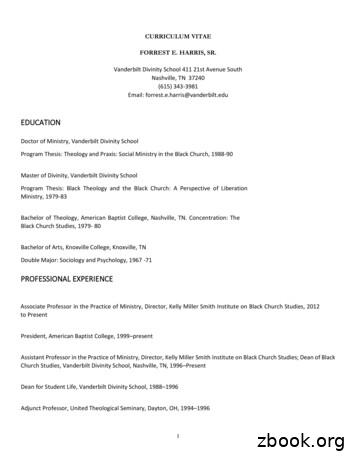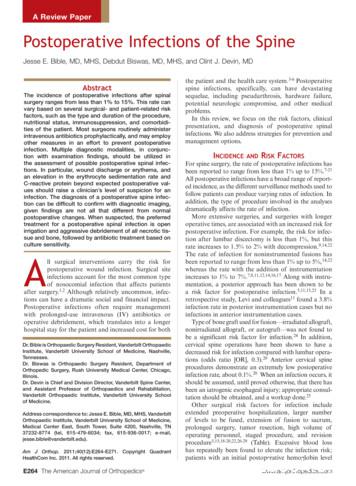Theory Of Transistors - Vanderbilt University
Theory of Transistorsand Other Semiconductor Devices1. SEMICONDUCTORS1.1. Metals and insulators1.1.1. Conduction in metalsMetals are filled with electrons. Many of these, typically one or two per atom inthe metal, are free to move about throughout the metal. When an electric field is applied,the electrons move in the direction opposite the field. Since they are negatively charged,this corresponds to a positive current in the direction opposite the motion, that is, in thedirection of the electric field:1.1.2. InsulatorsInsulators also have many electrons in them, but the electrons cannot move.Some of them are trapped in individual atoms and can't get away from them. Others arenominally free to move about but are locked in place by "gridlock." There are so manyelectrons that there is no place for an electron to move to, so it stays put even in anelectric field:
1.2. Semiconductors1.2.1. Intrinsic semiconductorsNot surprisingly, semiconductors are somewhat like metals and somewhat likeinsulators. As in atoms, the electrons in solids are in certain energy levels, or, morecorrectly, certain bands of energy levels, so this is called the band theory of solids. Inmetals, the uppermost band has a few electrons in it and these can move around, as in thefirst figure, above. In insulators the uppermost band is completely filled with electronsand they are gridlocked, as in the second figure , above. In semiconductors, the next-tothe highest band is almost completely filled with electrons and they are almostgridlocked. However, the highest band is only a little higher than the next-to-highest, anda few electrons jump into this band and conduct a little electricity. In addition, the holesleft in the band below give a little room for the gridlocked electrons to move. Actually,the holes look like positive charges (due to the positive ions left behind when theelectrons move away) and these holes appear to move in the direction opposite theelectrons. Therefore, the current carried by a semiconductor consists of the motion of thenegatively-charged electrons in the conduction band (the uppermost band) and thepositively-charged holes in the valence band (the next-to highest band).1.2.2. Doped semiconductorsThe electrical conduction in semiconductors can be improved by doping thesemiconductor with a small amount of some impurity. In a so-called n-typesemiconductor, atoms are added which contribute a few extra electrons to the conductionband:
In a so-called p-type semiconductor, atoms are added that "suck up" a fewelectrons from the valence band, leaving behind holes in the valence band.Thus, the dopant (the impurity added to the semiconductor) in a p-type semiconductoradds positive charge carriers (holes in the valence band), while the dopant in an n-typesemiconductor adds negative charge carriers (electrons in the conduction band).2. SEMICONDUCTOR JUNCTIONS AND DIODES2.1. p-n junction2.1.1. No electric fieldA p-n junction consists of a p-type semiconductor next to an n-typesemiconductor:When wires are connected to the ends, as shown, the device becomes a semiconductordiode.2.1.2. Reverse biasWhen an electric field is applied in the so-called reverse direction, the positivecharges on the one side are pulled away from the junction and the negative charges on theother side are pulled the other way away from the junction.
The charges move apart until the electric field across the junction gets too strong, and thecharges stop moving. A voltage applied in this way is called a bias.2.1.3. Forward biasWhen an electric field is applied in the forward direction, the opposite happens.The positive charge carriers (holes) move toward the junction from their side and thenegative charge carriers (electrons) move toward the junction from their side. But a holeis nothing more than an atom missing one of its electrons, so when a hole reaches thejunction at the same time as an electron, the electron falls into the hole and bothdisappear! This is called recombination.When recombination occurs, there is room for another electron and hole to move into thesame place and the process continues as long as the forward bias is maintained. Ofcourse, as the charge carriers move toward the junction and disappear, they are replacedat the ends by charges moving into and out of the wires.2.2. Diode rectifier2.2.1. RectificationDiodes have the property that they pass current in only one direction:
That is, they can be used to rectify an alternating current:The result is not "pure" direct current, but "pulsed" direct current. However, this is goodenough since there are many ways to smooth out the result.2.2.2. DetectionWhen an ac signal oscillates too fast, it is impossible for a slow device like avoltmeter to detect the voltage. The meter just hovers around zero. But if the voltage isrectified, then the meter can respond to the average of the rectified voltage. This is called"detection" of the signal:
2.3. Detection of a radio signal2.3.1. Tuning circuitThe radio-frequency signal from an antenna is an alternating current. In a radio,the speaker, or headphones, cannot keep up with the rf signal, but after it is detected thespeaker can respond.The signal from the antenna in a radio must first be tuned in to separate it fromother radio signals. This is done with a coil and a capacitor in a "tank circuit" (don't askme why it is called a tank circuit). The tank circuit shorts out signals at the "wrong"frequencies, but not at the desired frequency. This signal is then detected (rectified) bythe diode so the headphones can respond.In this radio, which has no batteries or other source of energy, all the power to drive theheadphones comes from the antenna. The power you hear comes out of the air!2.3.2. Diode detectorWhen the radio is used to transmit Morse code, the signal from the transmitterconsists of pulses of the "carrier" frequency of the radio station. When the radio is usedto transmit sounds, the signal from the transmitter consists of pulses at the carrierfrequency modulated at the audio frequency:After detection (and smoothing), the signal consists of pulses at the (much lower) audiofrequency, to which the headphones can respond:
3. TRANSISTORS AND TRANSISTOR CIRCUITS3.1. Double junction3.1.1. Emitter, collector and baseIn its essence, a transistor consists of two diodes arranged back to back:Transistors can be either n-p-n or p-n-p. The configuration shown above is called an n-pn transistor. The terminal on the left is called the emitter, the terminal on the right iscalled the collector, and the region in the middle is called the base.3.1.2. Biasing collector and emitterIn operation, the collector is reverse biased, relative to the base, so no currentflows, even if the voltage is large. On the other hand, the emitter can be forward biased,in which case a current flows even for a relatively small voltage.
3.1.3. Narrow base region; transistorWhat makes the transistor interesting is that the base region can be made verythin. When this is done, the negative charges that flow into the base region from theemitter are attracted to the collector before they can flow out the base connection. In thisway, the voltage on the emitter, compared with the base, controls the current in thecollector. This allows one connection to control the current another connection.3.2. Amplification3.2.1. Grounded emitter amplifierAs it would be drawn by an electrical engineer, the simplest amplifier circuitusing a transistor is
The funny symbol for a transistor comes from the fact that the first transistor didn’t looklike the block structure shown above. Rather, it was fabricated by taking a flat piece ofgermanium (the base) and attaching the emitter and base connections to the surface rightnear each other. As the metals from the wires diffused slightly into the surface theyformed the p-doped regions separated by a very small distance.This amplifier circuit can be used to improve the crystal radio:
In this circuit the power for the headphones comes from the battery, which has muchmore power than can be collected by the antenna. By the way, the funny symbol for thebattery represents the stack of copper and zinc disks and moistened cardboard that Voltause to make the first battery in 1800.3.3. Flip-flop and computer circuits3.3.1. Flip flop circuitThe basic computer circuit is called the flip-flop. It can exist in either of twostates. As shown, the output from the left-hand transistor (the collector voltage) is usedas the input to the right side (the base current), and vice versa. When the current isflowing in the left-hand transistor, the voltage at the collector is high (but negative) dueto the voltage drop in the resistor. When this high voltage is applied to the base of theright-hand transistor the collector current in that transistor is small. In fact, it can beessentially shut off. In this case the voltage at the collector on the right-hand side is low(that is, more negative), since there is no voltage drop across the resistor. This lowvoltage is applied to the base of the left-hand transistor, which causes the left-handtransistor to turn on, as we assumed in the first place. Thus, the circuit is stable in thisconfiguration.But the circuit shown above is symmetric, so either the right-hand light or the left-handlight can be "on." In fact, the state of the system can be flipped. If a signal is applied inthe right place, the circuit will flip. Specifically, if a negative voltage is applied to thebase of the transistor that is not conducting, then it will begin to conduct and turn theother transistor off. Thus, the circuit "remembers" the last input it received.
3.3.2. Computer memoriesComputers use millions (now billions) of these circuits to remember theinformation that is input. However, everything in the memory must be represented by 0'sand 1's, since flip-flops only have two states, corresponding to 0 or 1. This is whycomputers use the binary number system.
Theory of Transistors and Other Semiconductor Devices 1. SEMICONDUCTORS 1.1. Metals and insulators 1.1.1. Conduction in metals Metals are filled with electrons. Many of these, typically one or two per atom in the metal, are free to move about throughout the metal. When an electric field is
gate JL transistors, multi-gate JL transistors, silicon on insulator (SOI) JL transistors, and gate all around JL transistors. . For the SHE in FinFETs, various methods and the structures of transistors able to reduce this effect were considered in many works [11-15]. In [11], the charge plasma (CP) based JL MOSFET on a selective buried .
2009 Vanderbilt Football 2009 VANDERBILT FooTBALL VANDERBILT MISSISSIPPI STATE Location Nashville, Tenn. Starkville, Miss. Founded 1873 1878 Enrollment 6,402 17,824 Conference Southeastern Southeastern Nickname Commodores Bulldogs Colors Black & Gold Maroon & White Home Field Vanderbilt Stadium Davis Wade Stadium Capacity 39,773 55,082 Field Surface natural grass natural grass
Vanderbilt Divinity School 411 21st Avenue South Nashville, TN 37240 (615) 343-3981 Email: forrest.e.harris@vanderbilt.edu EDUCATION Doctor of Ministry, Vanderbilt Divinity School Program Thesis: Theology and Praxis: Social Ministry in the Black Church, 1988-90 Master of Divinity, Vanderbilt Divinity School .
Vanderbilt University, Department of Physics and Astronomy, Nashville, TN Associate Professor of Physics (1993-2000) Vanderbilt University, Department of Physics and Astronomy, Nashville, TN Assistant Professor of Physics (1986-1993) Vanderbilt University, Department of Physics and A
Whether a transistor is PNP or NPN can be found with the help of transistor data book. Fig 5 Low power Medium power High power transistors transistors transistors (less than (2 to 10 watts) (more than 2 watts) 10 watts) of metal known as heat sink. The function of heat sink is to, take away the heat from the transistor and pass it to air.
loans@vanderbilt.edu Financial Aid Overview. . Vanderbilt University Office of Student Financial Aid 615-322-3591 Anne.bathon@vanderbilt.edu. Title: Financial Aid 101 Author: SNG Created Date: 8/4/2020 2:47:53 PM .
Vanderbilt Orthopaedic Institute, Vanderbilt University School of Medicine. Address correspondence to: Jesse E. Bible, MD, MHS, Vanderbilt Orthopaedic Institute, Vanderbilt University School of Medicine, Medical Center East, South Tower, Suite 4200, Nashville, TN 37232-8774 (tel, 615-479-6034; fax, 615-936-0017; e-mail, .
Thin-fi lm transistors (TFT) however are fi eld-effect transistors manufactured by depositing thin fi lms of semiconducting and dielectric materials, as well as the electrical contacts, on a car-rier substrate. [1 ] Applications are in the fi eld of high-volume large-area electronics where numerous discrete transistors are


















